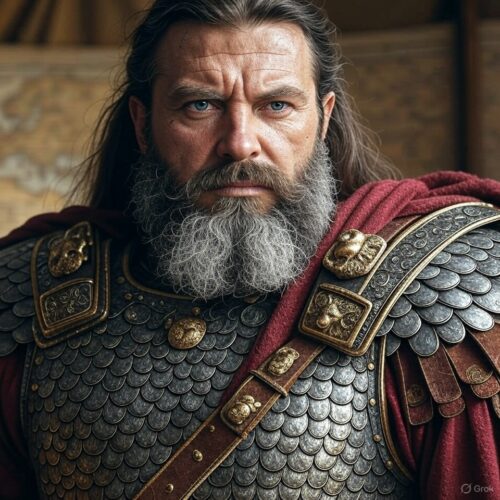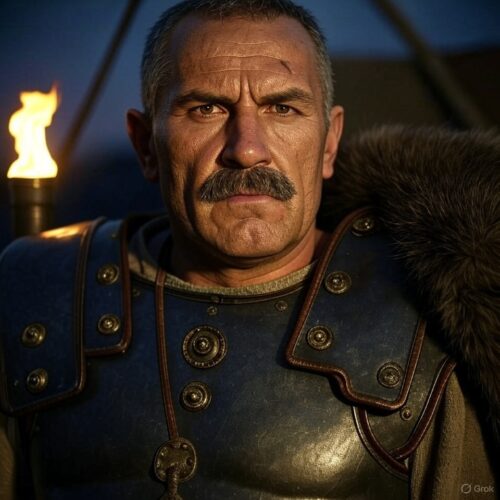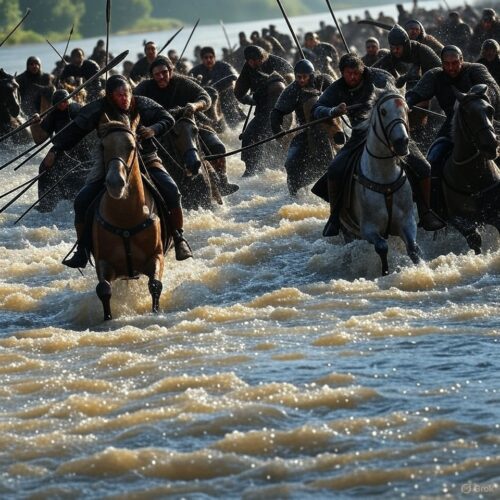Imagine a riverbank in northern Italy, where the waters of the Adda flow swift and unforgiving, carrying the echoes of clashing swords and the cries of warriors locked in a struggle that would reshape the fate of an empire’s remnants. On August 11, 490 AD, this seemingly ordinary stretch of water became the stage for one of history’s pivotal confrontations: the Battle of the Adda River. Here, Theodoric the Great, the ambitious king of the Ostrogoths, clashed with Odoacer, the barbarian ruler who had toppled the last Western Roman emperor. This wasn’t just a skirmish between rival warlords; it was a climax in the chaotic aftermath of Rome’s fall, a moment that blended brute force, cunning alliances, and the sheer will to survive. As we dive into this tale from distant history, we’ll uncover the gritty details of an era when empires crumbled and new kingdoms rose from the rubble. But beyond the blood and glory, we’ll explore how this ancient victory offers modern lessons in resilience, adaptability, and leadership—tools anyone can wield to conquer their own personal battles today.
Let’s journey back to the 5th century, a time when the once-mighty Western Roman Empire was gasping its last breaths. The year 476 AD marked a watershed: Odoacer, a Germanic chieftain of mixed Herulian and Scirian heritage, deposed the boy-emperor Romulus Augustulus in a bloodless coup. Rome, the eternal city, had fallen not to a grand invasion but to internal rot and barbarian mercenaries who had long served in Roman legions. Odoacer, born around 433 AD in the turbulent borderlands of the Danube, had risen through the ranks as a foederati leader—barbarian troops allied to Rome. His father, Edeko, had ties to the Huns under Attila, and Odoacer himself fought in various campaigns before leading a revolt against Orestes, Romulus’s father and the real power behind the throne. Upon victory, Odoacer spared the young emperor, pensioning him off to a villa in Campania, and proclaimed himself king of Italy. He ruled from Ravenna, the swampy, defensible capital that had replaced Rome as the imperial seat.
Odoacer’s reign was pragmatic and surprisingly stable. He maintained Roman administrative structures, distributed land to his followers without massive confiscations, and even minted coins in the name of the Eastern Roman Emperor Zeno in Constantinople to legitimize his rule. As an Arian Christian (a sect that denied the full divinity of Christ, differing from orthodox Catholicism), he tolerated the Chalcedonian church and won support from the Roman Senate. Diplomatically savvy, he ceded Sicily to the Vandals for peace and crushed the Rugians in Noricum (modern Austria) in 487-488, expanding his influence. Yet, his kingdom was a patchwork of Germanic tribes—Heruli, Sciri, Rugii, and others—lacking the cohesion of a single nation. Italy under Odoacer was a bridge between Roman antiquity and the medieval world, but it was built on shaky foundations.
Enter Theodoric, a figure straight out of epic legend. Born in 454 AD near Carnuntum in Pannonia (modern Austria), Theodoric was the son of Theodemir, king of the Ostrogoths, and Ereleuva, a concubine with Roman ties. As a child of seven or eight, he was sent as a hostage to Constantinople, where he absorbed Roman culture, military tactics, and diplomacy. Returning around 470 AD, he inherited leadership and navigated the treacherous politics of the Eastern Roman Empire. By 471, he was king of the Ostrogoths, a people descended from the Greuthungi Goths who had split from the Visigoths after the Battle of the Catalaunian Plains in 451 AD against Attila. Theodoric served Emperor Zeno as a commander, earning the title of consul in 484, but their relationship soured with rebellions and rivalries.
In 488 AD, Zeno saw an opportunity: commission Theodoric to invade Italy and remove Odoacer, killing two birds with one stone by ridding himself of a troublesome ally and stabilizing the West. Theodoric, facing food shortages and pressure from neighboring tribes like the Gepids, agreed. What followed was no mere military campaign—it was a mass migration. Estimates suggest 40,000 Ostrogothic warriors, accompanied by 160,000 women, children, and elders, trekked westward in wagons laden with belongings. This “nation on the move,” as chronicler Procopius described it, crossed the Danube, battled the Gepids at the Ulca River for passage, and endured harsh winters in the Balkans. Ennodius, bishop of Pavia and Theodoric’s panegyrist, poetically noted: “A world migrates with you to the Ausonian land, a world every member of which is nevertheless your kinsman.”
By August 489 AD, the Ostrogoths reached the Isonzo River (modern Soča) in northeastern Italy. Odoacer, forewarned, met them there on August 28. The battle was fierce; Theodoric’s forces, driven by the desperation of migrants with nowhere to go, overwhelmed Odoacer’s defenses. Odoacer retreated to Verona, where another clash on September 30 saw Theodoric victorious again. He proclaimed himself king, but betrayal loomed. Tufa, a Rugian general who defected to Theodoric, switched sides back to Odoacer, forcing Theodoric to hole up in Pavia (Ticinum) for the winter.
The year 490 AD brought reversals. Odoacer, bolstered by Burgundian allies from Gaul, besieged Theodoric in Pavia and won a skirmish at Faenza. But Theodoric broke out, rallying his forces and securing aid from his Visigothic kinsman, King Alaric II (namesake of the sacker of Rome in 410). United Gothic armies—Ostrogoths with their heavy cavalry and infantry, Visigoths adding numbers—marched toward Milan.

This sets the scene for August 11, 490 AD, on the banks of the Adda River, about ten miles east of Milan. The Adda, a tributary of the Po, was swollen from summer rains, its waters churning between steep banks—a natural barrier Odoacer hoped to exploit. His army, a multinational coalition of Heruli, Sciri, Rugii, and possibly Thuringians and Alamanni, numbered in the tens of thousands, though exact figures are lost to time. Chroniclers like Ennodius spoke of “so many kings” under Odoacer’s banner, highlighting its diversity but also potential disunity. Odoacer positioned his troops defensively, using the river as a moat, with archers and spearmen ready to repel crossings.
Theodoric’s force, similarly sized but more cohesive as a tribal nation, included battle-hardened Ostrogoths and Visigothic reinforcements. His warriors were equipped with long swords, shields, and chainmail, excelling in mounted charges—a legacy of steppe influences from their Hunnic interactions. Tactics were straightforward yet brutal: Theodoric aimed to force a crossing, leveraging Gothic ferocity to break Odoacer’s lines.
The battle erupted at dawn. Theodoric’s scouts probed for weak points, and under cover of arrow volleys, Gothic infantry waded into the Adda. The current was treacherous; men drowned in armor, but others reached the far bank, clashing with Odoacer’s defenders in muddy melee. Ennodius described it as a “terrible slaughter on both sides,” with the river running red. A key moment came when Visigothic allies flanked from the south, exploiting a ford. Odoacer’s lines buckled; his Count of the Domestics, Pierius—a trusted advisor—fell in the fighting, sowing panic.
By midday, Theodoric’s forces gained the upper hand. Odoacer, seeing defeat, ordered a retreat to Ravenna, leaving behind thousands dead. The Goths pursued, but the battle’s toll was immense—perhaps 10,000 casualties total, though sources exaggerate for drama. This victory wasn’t just military; it shattered Odoacer’s aura of invincibility.

In the aftermath, Italy descended into vengeance. Ennodius called it a “sacrificial slaughter,” with Theodoric’s agents hunting Odoacer’s loyalists across provinces. Cities like Milan and Pavia opened gates to the victor, weary of war. Odoacer barricaded in Ravenna, protected by marshes and fortifications, endured a three-year siege. Food shortages plagued both sides; Theodoric blockaded supplies, while Odoacer’s raids harassed foragers.
Finally, on February 2, 493 AD, a treaty made them joint rulers. But at a banquet on March 15, Theodoric personally slew Odoacer, cleaving him from shoulder to hip, reportedly quipping, “There certainly wasn’t a bone in this wretched fellow.” Odoacer’s family suffered: his wife Sunigilda starved in prison, his son Thela exiled and later killed. Theodoric’s massacre of Odoacer’s followers ensured no rivals.
Theodoric’s 33-year reign brought prosperity. He restored aqueducts, baths, and walls in Rome, rebuilt the Palace of Domitian, and constructed grand churches in Ravenna like Sant’Apollinare Nuovo. His mausoleum, a domed stone marvel, stands today. Governing as “king of the Goths and Romans,” he used Roman law for Italians and Gothic customs for his people, fostering integration without assimilation. Marriages allied him with Vandals, Burgundians, and Franks; by 511, he was regent for the Visigoths, creating a Gothic “superstate” from Spain to the Danube.
Yet, his Arian faith clashed with Catholic Romans, especially later. Tensions with Byzantium under Justin I led to executions, including philosopher Boethius in 524 for alleged treason. Theodoric died in 526 AD, succeeded by grandson Athalaric under regent Amalasuintha. His legacy? A bridge to the Middle Ages, inspiring legends as Dietrich von Bern in Germanic epics. Historians like Jordanes (in Getica) and Cassiodorus praised him as a restorer of Roman glory, while modern scholars debate if he was emperor in all but name.

Delving deeper into the era’s context enriches our understanding. The 5th century was the “Migration Period,” with Germanic tribes—Goths, Vandals, Franks—redrawing Europe’s map amid Hunnic pressures and Roman decline. The Ostrogoths, once subjects of the Huns, regained independence after Attila’s death in 453 AD. Theodoric’s education in Constantinople instilled respect for Roman institutions, making him a “barbarian” who admired civilization. Odoacer, conversely, represented the foederati system gone awry—barbarians defending Rome until they claimed it.
Primary accounts come from biased sources: Jordanes’ Getica (551 AD), based on Cassiodorus’ lost Gothic history, glorifies Theodoric. Procopius’ Wars (6th century) offers Byzantine views, portraying both as tyrants. Ennodius’ panegyric flatters Theodoric, emphasizing divine favor. Archaeological evidence, like Ravenna’s mosaics depicting Theodoric’s court (later altered to erase him), confirms his building spree. Coins from his reign blend Roman imperial imagery with Gothic kingship, symbolizing hybrid rule.
The battle’s significance ripples through history. It ended the first post-Roman kingdom in Italy, paving for Ostrogothic stability that delayed Byzantine reconquest until 535 AD under Justinian. Without Theodoric’s victory, Italy might have fragmented further, altering the Renaissance’s roots. Fun fact: Theodoric’s mausoleum, with its massive monolithic roof, baffles engineers today—how did they lift that 300-ton stone without modern tech? It’s a testament to Gothic ingenuity blended with Roman engineering.

Shifting from history’s depths to today’s relevance, the Battle of the Adda’s outcome—Theodoric’s triumph leading to a golden age of governance—teaches us about turning adversity into advantage. In an age of uncertainty, like economic shifts or personal setbacks, emulating Theodoric’s resilience can transform lives. His victory wasn’t luck; it was persistence through migration hardships, betrayals, and battles. Today, apply this by building adaptability, forging alliances, and integrating diverse strengths.
Here’s how you benefit from this historical fact in your individual life:
– **Cultivate Unyielding Resilience**: Just as Theodoric endured a grueling migration and defeats like Faenza before winning at Adda, face your challenges head-on. Benefit: Reduced stress from setbacks, leading to faster recovery in career or health crises.
– **Forge Strategic Alliances**: Theodoric’s pact with Alaric II turned the tide; seek mentors or partners in your endeavors. Benefit: Expanded networks that open doors to new opportunities, like job promotions or collaborative projects.
– **Embrace Cultural Integration**: Theodoric governed Romans and Goths separately yet harmoniously; blend diverse skills or backgrounds in your life. Benefit: Enhanced creativity and problem-solving, useful in multicultural workplaces or personal relationships.
– **Invest in Long-Term Stability**: Post-victory, Theodoric restored infrastructure; prioritize sustainable habits over quick wins. Benefit: Improved financial security through consistent saving or skill-building.
– **Lead with Vision**: Theodoric’s education shaped his rule; pursue lifelong learning to guide your path. Benefit: Greater confidence in decision-making, from daily routines to life-changing choices.
To apply this practically, follow this step-by-step plan:
- **Reflect on Your ‘Migration’**: Spend 15 minutes daily journaling past hardships, like Theodoric’s trek. Identify lessons learned to build mental fortitude.
- **Build Your ‘Alliance Network’**: Reach out to one new contact weekly— a colleague, friend, or expert—mirroring Theodoric’s Visigothic aid. Discuss mutual goals.
- **Integrate Diverse Elements**: Audit your routine; incorporate one new habit from a different culture or field each month, such as learning a language or trying a new cuisine, to foster adaptability.
- **Restore Your ‘Infrastructure’**: Dedicate weekends to self-improvement, like exercising or budgeting, akin to Theodoric’s building projects. Track progress in a app.
- **Celebrate Small Victories**: After achieving a goal, reward yourself modestly, remembering the Adda’s turning point. This sustains motivation for larger battles.
By channeling the spirit of August 11, 490 AD, you don’t just survive—you thrive, turning history’s lessons into personal empire-building. Who knew a 1,500-year-old river skirmish could be your secret weapon?


